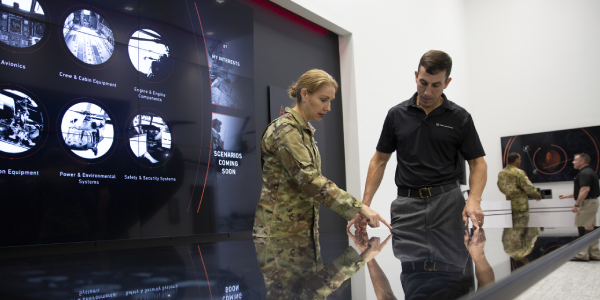
Collins Aerospace’s MOSARC avionics solution breaks vendor lock (image courtesy of Collins Aerospace).
In this Q&A with Collins Aerospace, we talk with Ryan Bunge, vice president and general manager for Communications, Navigation, and Guidance, and Chip Gilkison, director, Customer Capabilities and Requirements for Military Avionics. The pair covers a range of topics including the company’s vision for open systems, its MOSARC avionics solution that breaks vendor lock, how legacy fleets can benefit from open systems and provide risk reduction for the Army’s Future Vertical Lift (FVL) program, and how mission systems like Air Launched Effects will benefit from openness.

Ryan Bunge, vice president and general manager for Communications, Navigation, and Guidance, Collins Aerospace.
Breaking Defense: What does it mean to Collins to have truly “open systems,” especially as it relates to FVL, as well as modernization of legacy fleets?
Bunge: To us, open systems are flexible and extensible so customers can rapidly upgrade the capabilities that they need to perform the mission and do it in an affordable manner that breaks vendor lock. At its core, open systems architectures grant operators the flexibility to address their requirements in the way they need to meet the ever evolving mission. They can upgrade, add, remove, or modify software as dictated by the mission.
At Collins, we’ve been pioneering open systems for over 30 years. That includes our involvement in consortiums such as OMS, OCS, FACE, SOSA, NIIA, and STANAG, and developing systems to open standards in advance of stated customer requirements such as the Common Avionics Architecture System (CAAS) Avionics Management System that is on US Army Blackhawks and Chinooks, as well as the Flight2 Integrated Avionics System for KC-135 and C-130 fleet modernization worldwide.
As we think ahead, the focus on near peers is driving a renewed focus on open systems and making sure we get it right — for both Future Vertical Lift and the enduring fleet. There’s no one software application, no one wave form, no one set of capabilities that is going to consistently provide the warfighter with what they need from day one of that conflict.
Open systems are needed to rapidly pace the threat with new capabilities and do so in an affordable manner and somewhat autonomously. The vision is consistent but the devil’s in the details of how you go about implementing that in a forward-looking manner for FVL while at the same time bringing along capabilities for the enduring fleet to retain some of their interoperability and deal with the fact that you’re going to be flying these aircraft for another 20-30 years.
Breaking Defense: What would be the panoply of FVL-related systems and products that are most suitable to being open, modular, and upgradable over time?
Bunge: Three areas come to mind. For FVL or any new modernization platform, I would start with ensuring that you’re building the platform to be appropriately open, which means that you’ve got to have the right digital backbone to plug into. That’s what we’re doing with our open systems avionics offering that we call MOSARC, which ensures that you’re architected to be upgradeable and extensible right off the bat. We’ll talk more about MOSARC later in this discussion.
Second, when you look at what’s going to pace the threat, where we are going to see change, and where we need to inject new capabilities, it is open mission systems that will allow for integration of things like Air Launched Effects (ALE). In the case of a Future Attack Reconnaissance Aircraft that will operate at the forward edge of the contested area, for example, it will be able to extend its penetration and capabilities into the battlespace by pairing with ALE. So building open systems with the right connectivity tools, cross-domain solutions, and secure processing will let you host the capabilities that you need.
To serve the Open Mission Systems need, we’ve developed the RapidEdge Mission System which we used as a baseline for our ALE Mission System Solutions. RapidEdge enables ALEs to quickly integrate new capabilities to ensure dominance in the modern battlespace, a feature successfully demonstrated in increment 1A of the program. RapidEdge acts as the brain of the system and includes a complete small form factor mission system with radios for communication, solutions for handling multiple levels of classified data, PNT, mission computing, and autonomous behaviors for ALE.
Through advanced fusing of time-critical targeting data derived from air vehicles, payloads, and networked sensors, our mission system for ALE enables decentralized autonomy to allow the ALEs to decide as a team on the best way to achieve their commanded mission objectives. The ALE team is able to leverage all of these capabilities to reduce operator workload on manned platforms and increase the reach, lethality, and survivability of air crews operating in any anti-access/area-denial environment.
The last area is one that might be less intuitive, but that’s driving the open systems concept down to a subsystem level. As we think about the future battlespace, contested RF environments, Joint All Domain Command and Control, and the Army’s Integrated Tactical Network, the ability to have open systems at the connectivity level lets you to pace the threat in terms of rapidly closing sensor-to-shooter networks, playing through contested GPS-denied environments with Assured PNT (APNT) capabilities, and securing communications through network AI.
That’s key to what we’re doing in our communications business through an open-systems, adaptive-connectivity product we call FlexLink. This is a communication, navigation, and surveillance (CNS) solution that delivers the resilient networks and APNT needed to connect the battlespace and rapidly adapt to outpace the threat. FlexLink’s streamlined CNS system integrates an extensive list of capabilities that would normally require more than 30 line-replaceable units and antennas on next-generation aircraft, all in a form factor compliant with the Army’s CMOSS CMFF architecture.
Breaking Defense: How are you incorporating the Army’s Modular Open Systems Approach (MOSA) into development of your systems, specifically those with applicability to FVL? And how does MOSARC fit in?

Chip Gilkison, director, Customer Capabilities and Requirements for Military Avionics, Collins Aerospace.
Gilkison: I think the Army’s MOSA transformation office has been doing a fantastic job of setting priorities and visions. They have been taking input and listening to industry to truly understand the art of the possible.
What helps to keep us grounded is trying to consider how to best meet the intent of open systems. Ultimately, open-system architectures grant operators the flexibility to meet the requirements for their mission and how they want to meet them. As Ryan said, they can upgrade, add, remove, and modify software as dictated by the mission. They have that flexibility without having to go back to one vendor who makes only their own software. That allows them to on-ramp new technologies as they emerge, which lowers the cost due to commercial commonality with other platforms.
With that in mind, we’ve developed MOSARC, which we consider a revolutionary approach to aircraft integration. We start with a digital backbone that meets government open-systems standards while ensuring the separation of air vehicle and mission-system equipment and the ability to manage the exchange of information between the two. This increases performance, safety, and cybersecurity, while enabling rapid third-party integration into the field for current and future warfighters.
It focuses on new solutions needed to accommodate for higher data rates and throughput. We wouldn’t ask the Army to tell us what those data and throughput rates need to be, just tell us what they’re trying to accomplish and we’ll architect it as efficiently as possible. We believe that’s the best way to proceed because algorithms are having an exponential impact on the needs for processing, which are doubling every 4-6 months.
We’re looking at commercial standards, such as time-sensitive networking, to update those networks so that they can evolve faster and be smarter as they’re handling this need for new data. We believe that certified core processing running safety critical apps across all cores is the only way to keep up with this evolution.
Oftentimes, safety-critical applications don’t get enough attention until it’s too late. These applications are your insurance policy while flying. It takes a bit more effort to get them certified, but when you need them to work, you need to be able to be 100-percent confident that they will function to keep the aircraft flying. We look at the commercial industry and see that it’s built on safety certification. As the government adopts more safety certifications and standards, we’ll be able to comply with all of them.
Breaking Defense: MOSARC is not just for FVL but also for modernizing the enduring fleet. Correct?
Gilkison: Yes. We’re not suggesting we tear out a cockpit and put MOSARC in. We’re saying let’s pick and choose where it makes sense. If something’s getting long in the tooth, we can update that. And it will be easy because we’re complying with open standards.
MOSARC also applies to the entire aircraft. So whether you’re thinking about mechanical or mission systems, or power and controls, MOSARC can bring all of those together seamlessly because all of it is data driven. For logistics and support, we can collect all that data and get it to the maintenance folks on the ground in real time while missions are being flown. This increases efficiency so you can accomplish more missions more often.
Finally, we think that arguably the biggest part of it is being able to rapidly integrate third parties. The Army should not be beholden to one vendor to make it all happen and be wholly reliant on that vendor’s expertise in different mission software.
We’ve already demonstrated how we can bring in other companies, systems, and applications at our newly inaugurated open systems center of excellence in Huntsville.
For example, in collaboration with General Atomics, Parry Labs, Tektonux, and Palantir Technologies, Collins served as the integration lead bringing together individual capabilities of government/third-party software and multiple third-party mission computers into our mock rotary wing flight deck using Collins’ digital backbone, hardware, software, and integration expertise.
A total of 19 different FACE Units of Portability were integrated into the mock flight deck, demonstrating that these components had the ability to be moved from one aircraft to another or replaced by a compatible component.

The Collins Customer Experience Center in Huntsville, AL, demonstrates how the company brings together third parties, systems, and applications.
Breaking Defense: Let’s talk more about using open systems to modernize the enduring fleet. In what areas specifically?
Bunge: With FVL full-rate production slated for the 2030s and 30-40 aircraft produced per year, it will take a long time to replace 2,000 Blackhawks. This means that the enduring fleet could be flying for 20-30 more years and needs to be prepared to face any conflicts that arise during that time.
Modernizing the enduring fleet offers a way for the Army to test new technology for FVL and reduce risk. At the same time, it also helps ensure commonality across the Army fleet.
In that regard, we have several activities where we’re working with the Army to modernize some of their communications and open systems capabilities. In one program, Collins is working with PM Aerial Communications and Mission Command in the Program Executive Office for Aviation at Redstone Arsenal in Alabama to bring an open-systems approach to the modernization of their legacy SINCGARS capability by replacing the ARC-201D with an open and modern, multi-channel software-defined Manpack radio.
In thinking about that program in a multi-domain context, we’re also working on capabilities around sensing the RF spectrum and providing resilient, multi-path connectivity from air to ground, as well as reach back beyond line of sight to help enable multi-domain operations.
Collins is also bringing 3G/4G communications to the enduring fleet through the upgrade and modernization of the AN/ARC-220 HF Airborne Communication System, which is fielded on all Army Blackhawk, Chinook, and Apache helicopters, and provides embedded Automatic Link Establishment, serial tone data modem, text messaging, and GPS position reporting functions.
Those two programs will not only modernize the enduring fleet for today but will bring additional capability like MUOS and TSM with WREN Security for future growth and interoperability with the ground platforms and soldiers.





















